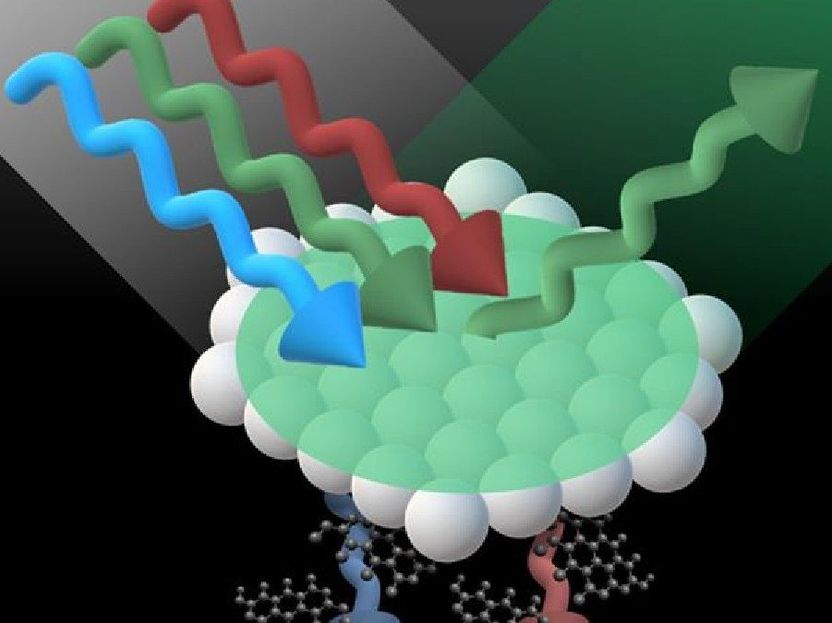Pretty as a peacock: The gemstone for the next generation of smart sensors
Method represents a simple, inexpensive and scalable approach to produce multi-functional graphene infused synthetic opals
Scientists have taken inspiration from the biomimicry of butterfly wings and peacock feathers to develop an innovative opal-like material that could be the cornerstone of next generation smart sensors.

University of Surrey
An international team of scientists, led by the Universities of Surrey and Sussex, has developed colour-changing, flexible photonic crystals that could be used to develop sensors that warn when an earthquake might strike next.
The wearable, robust and low-cost sensors can respond sensitively to light, temperature, strain or other physical and chemical stimuli making them an extremely promising option for cost-effective smart visual sensing applications in a range of sectors including healthcare and food safety.
In a study published by the journal Advanced Functional Materials, researchers outline a method to produce photonic crystals containing a minuscule amount of graphene resulting in a wide range of desirable qualities with outputs directly observable by the naked eye.
Intensely green under natural light, the extremely versatile sensors change colour to blue when stretched or turn transparent after being heated.
Dr. Izabela Jurewicz, Lecturer in Soft Matter Physics at the University of Surrey's Faculty of Engineering and Physical Sciences, said "This work provides the first experimental demonstration of mechanically robust yet soft, free-standing and flexible, polymer-based opals containing solution-exfoliated pristine graphene. While these crystals are beautiful to look at, we're also very excited about the huge impact they could make to people's lives."
Alan Dalton, Professor Of Experimental Physics at the University of Sussex's School of Mathematical and Physical Sciences, said: ""Our research here has taken inspiration from the amazing biomimicry abilities in butterfly wings, peacock feathers and beetle shells where the colour comes from structure and not from pigments. Whereas nature has developed these materials over millions of years we are slowly catching up in a much shorter period."
Among their many potential applications are:
- Time-temperature indicators (TTI) for intelligent packaging - The sensors are able to give a visual indication if perishables, such as food or pharmaceuticals, have experienced undesirable time-temperature histories. The crystals are extremely sensitive to even a small rise in temperature between 20 and 100 degrees C.
- Finger print analysis - Their pressure-responsive shape-memory characteristics are attractive for biometric and anti-counterfeiting applications. Pressing the crystals with a bare finger can reveal fingerprints with high precision showing well-defined ridges from the skin.
- Bio-sensing - The photonic crystals can be used as tissue scaffolds for understanding human biology and disease. If functionalised with biomolecules could act as highly sensitive point-of-care testing devices for respiratory viruses offering inexpensive, reliable, user-friendly biosensing systems.
- Bio/health monitoring - The sensors mechanochromic response allows for their application as body sensors which could help improve technique in sports players.
- Healthcare safety - Scientists suggest the sensors could be used in a wrist band which changes colour to indicate to patients if their healthcare practitioner has washed their hands before entering an examination room.
The research draws on the Materials Physics Group's (University of Sussex) expertise in the liquid processing of two-dimensional nanomaterials, Soft Matter Group's (University of Surrey) experience in polymer colloids and combines it with expertise at the Advanced Technology Institute in optical modelling of complex materials. Both universities are working with the Sussex-based company Advanced Materials Development (AMD) Ltd to commercialise the technology.
Joseph Keddie, Professor of Soft Matter Physics at the University of Surrey, said: "Polymer particles are used to manufacture everyday objects such as inks and paints. In this research, we were able finely distribute graphene at distances comparable to the wavelengths of visible light and showed how adding tiny amounts of the two-dimensional wonder-material leads to emerging new capabilities."
John Lee, CEO of Advanced Materials Development (AMD) Ltd, said: "Given the versatility of these crystals, this method represents a simple, inexpensive and scalable approach to produce multi-functional graphene infused synthetic opals and opens up exciting applications for novel nanomaterial-based photonics. We are very excited to be able to bring it to market in near future."
Original publication
Other news from the department science
These products might interest you
Most read news
More news from our other portals
See the theme worlds for related content
Topic world Sensor technology
Sensor technology has revolutionized the chemical industry by providing accurate, timely and reliable data across a wide range of processes. From monitoring critical parameters in production lines to early detection of potential malfunctions or hazards, sensors are the silent sentinels that ensure quality, efficiency and safety.

Topic world Sensor technology
Sensor technology has revolutionized the chemical industry by providing accurate, timely and reliable data across a wide range of processes. From monitoring critical parameters in production lines to early detection of potential malfunctions or hazards, sensors are the silent sentinels that ensure quality, efficiency and safety.
































































